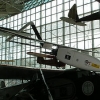RoboStuff
Robotics news, projects and stuff
-
Insitu Aerosonde
Posted on March 18th, 2009 No comments The Aerosonde is a small unmanned aerial vehicle (UAV) designed to collect weather data, including temperature, atmospheric pressure, humidity, and wind measurements, over oceans and remote areas. On August 21, 1998 a Phase 1 Aerosonde completed a 2,031 mile (3,270 km) flight across the Atlantic Ocean.
The Aerosonde is a small unmanned aerial vehicle (UAV) designed to collect weather data, including temperature, atmospheric pressure, humidity, and wind measurements, over oceans and remote areas. On August 21, 1998 a Phase 1 Aerosonde completed a 2,031 mile (3,270 km) flight across the Atlantic Ocean.
 RSS
RSS Contact Us
Contact Us